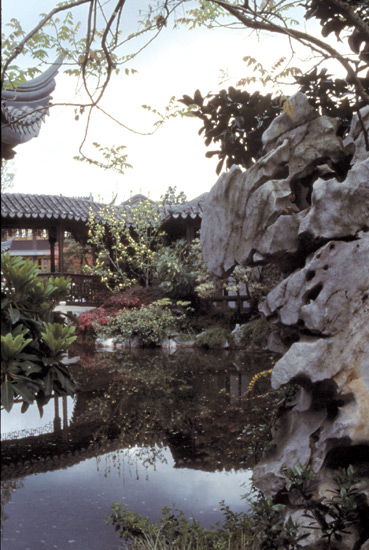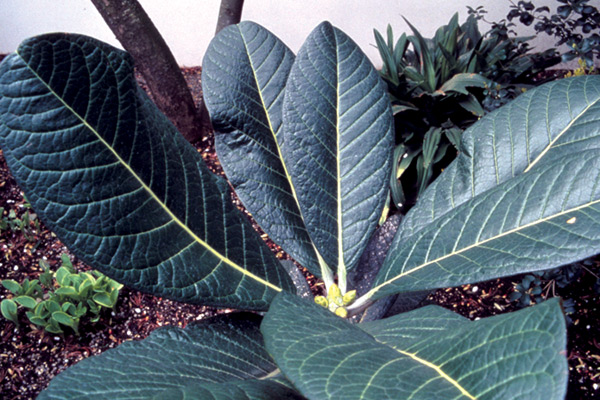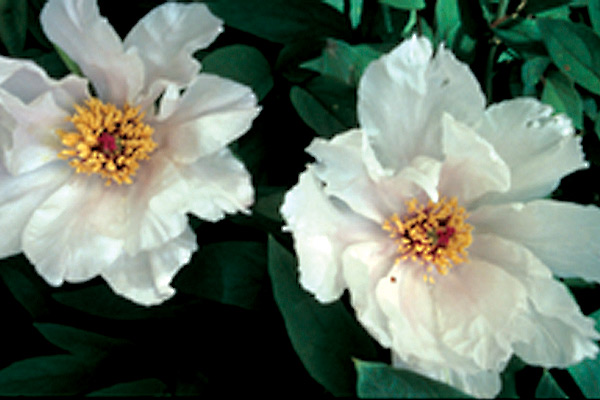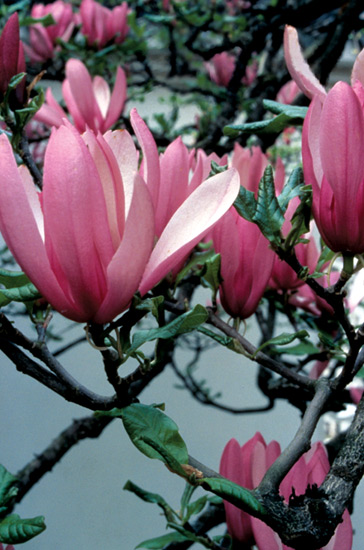JARS v61n1 - Portland's Classical Chinese Garden
Portland's Classical Chinese Garden
Garden of Awakening Orchids
Peter Kendall
Portland, Oregon
The Portland Classical Chinese Garden was borne of an idea and collaboration that arose some twenty years ago. At that juncture, Portland approached the city of Suzhou, located approximately 100 kilometers northwest of Shanghai in the delta of the Yangtze River, to become its partner in creating a garden of classical distinction (it became a sister city in 1988). Suzhou is situated in an ideally temperate area and fortuitously endowed with water and rock resources. Backed by these circumstances and beginning in the 10th century (during the Song dynasty from 960 AD to 1279 AD), this city of noted cultural sophistication and elegant grace began its move toward gardens of the highest renown. Although Portland's Chinese garden represents a traditional intimate garden (only one city block in extent) found later during the Ming dynasty from 1368 AD-1644 AD, it nonetheless embodies all that the Song dynasty presaged some four centuries earlier.

|
|---|
Reflected scene near Pavilion showing typical upturned roof and phantasmagoric rock from Lake Tai Hu. Photo by Peter Kendall |
It was in the 10th century, also, that the second of the prevailing Chinese philosophical constructs came to the fore. This concept, Taoism, proved markedly different from Confucianism, which had long held sway throughout China. Where Confucianism was highly orderly and hierarchal with the idea of fostering a cohesive social fabric, Taoism became an enterprise of free flowing thought with naturalistic impulses. Painting, literature, poetry, drama, music and other arts had long been integral to Chinese culture. Painting (principally a water based black ink applied with exquisite nuance) in particular had attained the highest levels of accomplishment and appreciation. The advent of Taoism, with its emphasis on the free interplay of opposites (yin-yang) and a harking back to nature, came to engender a dimension of which Confucianism had not allowed. These forces propelled the culture in the most imaginative ways.
Gardens were conceived and constructed that embodied the tenets of Taoism with its elegant restraint while accommodating the basic axioms of Confucianism. As space was limited in urban areas, gardens were created which conceptually miniaturized nature while providing a dynamic leitmotif. The art of penjing (the potted landscape and the forerunner of bonsai in Japan) became an icon. Plentiful rock and stone was scrupulously assembled and built, on the one hand, into hills and mountains and, on the other hand (in the form of elaborately eroded limestone specimens from Lake Tai Hu - the Grand Lake), into natural sculpture for close-up viewing.

|
|---|
Example of upturned roof and elaborately eroded stone from Lake Tai Hu. Photo by Peter Kendall |
This surrounded and interspersed a predominant architecture that put a living habitat at the forefront of objectives. As space was limited, certain devices were conceived to create the illusion of space within narrow confines. Structures were erected with up-curved roofs to produce a floating effect and delicacy otherwise unattainable. Unobtrusive corridors or strolling areas with whitewashed stucco walls as foils for objects and their shadows were used to connect the various buildings. These same corridors were frequently paved in elaborate mosaic tile. Along these corridors and within the buildings, fenestrations or windows were provided for captivating views in the manner of elegant landscape paintings. The moon-viewing entrance portico was part of this tradition.

|
|---|
Moongate. Photo by Peter Kendall |
The transition from static to mobile viewing (hide and reveal) became an outcome of this device. Undulation of the walking area and numerous curvilinear pathways added to this feeling of spaciousness in abbreviated areas. Water became an indispensable element in setting the stage for a suspension of disbelief. A placid pond and slow flowing stream became perfect mirrors of what surrounded them and multiplied the space accordingly. Bridges became vehicles for close-up viewing as one meandered from place to place. The ubiquitous pavilion with its proximity to the placid pond became the center point of all activity.
With architecture, stone and water firmly in place, plants were introduced to add texture and transitional features to a fundamental structure. Plants with an open structure and broadleaved evergreens were most sought after. (Rhododendrons comprise the largest plant group in Portland's garden.) The "four virtuous gentlemen" - plum blossom trees, orchids, bamboo and chrysanthemum, each accenting the other - were used for contrasting texture and the color of leaves and flowers. Plants of limited growth were favored with trimming and root pruning to accentuate the natural; no topiary was permitted. Plants were selected to provide a scale from the large (banana leaves) to the small (the smallest perennials) to inject life into the surroundings. The overall scale was exquisitely compatible with the overall scene.
Literature, poetry, calligraphy and wood carving of the highest stature were features that offered an added degree of refinement as one negotiated the layout of the garden. Beyond the garden, scenery was borrowed (where possible or deleted where deemed deleterious) to enhance the prevailing experience.
The five senses and the four seasons became the basis for changing experiential settings within an overreaching concept of expanding the imagination within a limited area. Plants, in particular, contributed to this moving focus of sense in a seasonal world. The senses of sight (spring flowers, winter traceries, exfoliating bark, fall color, etc.), sound (the fluttering or rustling of leaves, the patter of rain), smell (the sweet fragrances of innumerable flowers), couch (throughout the year), and taste (at various times) were each masterfully introduced and manipulated to elucidate the heightened response of the garden stroller.

|

|
|
|---|---|---|
Rhododendron sinogrande Photo by Peter Kendall |
Paeonia Photo by Peter Kendall |

|
|---|
Magnolia x soulangeana Photo by Peter Kendall |
Portland's Chinese garden offers a most succinct and delightful example of the many aspects of a truly classical garden Constructed on site with Suzhou artisans of the highest caliber and stocked with native Chinese flora most suitable to the particular locale, this garden beckons among outstanding gardens of the world.
Peter Kendall, a member of the Portland Chapter, is a landscape designer.

